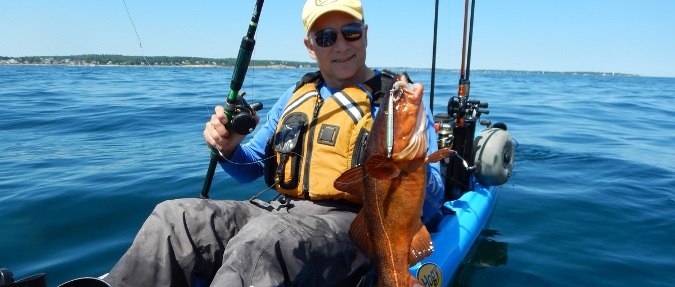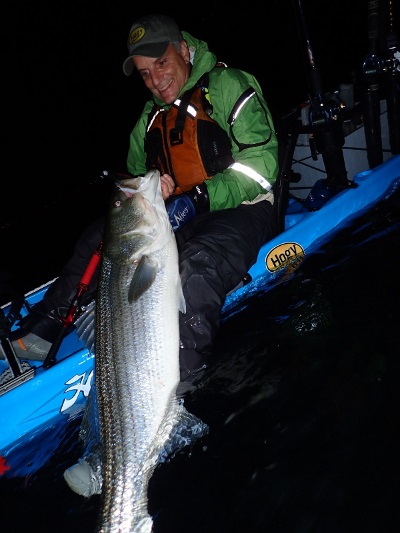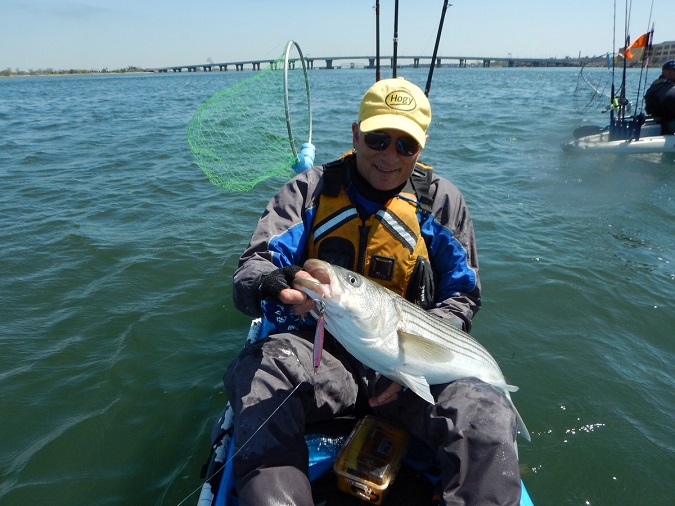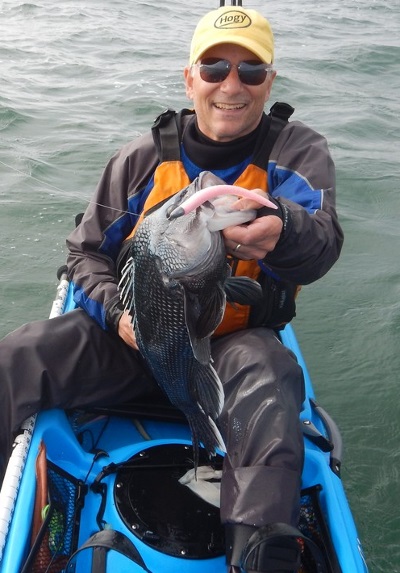Everyone knows that Chicago is the windy city and that Seattle gets plenty of rain, but most people don’t know that Boston is windier than Chicago and gets more rain than Seattle. While it’s true that most people don’t know that, I guarantee you that every kayak fisherman in the Northeast knows it! And it isn’t just Boston; the whole region is windy with plenty of rain thrown in for good measure. For those of us addicted to the salt, we also have to deal with 8’ to 13’ foot tides that kick up some monster currents.

With a season already shortened by snow and ice, it is hard to give up more days due to weather. Those of us who are addicted to our time on the water have developed strategies and techniques for dealing with wind and current. Striped bass are my favorite local target and there’s nothing like wind and current to put them on the feed—those calm still days are never as productive because stripers like moving water.
Current is typically easier to deal with than the wind because it is predictable; a check of the tide tables will show how big the tide is and which way the current is moving. Developing local knowledge of the currents is critical to success; incoming and outgoing tides create rips (strong currents) in very specific spots. These rips can come and go during a tide and fish may only hold on them for part of a tide. One general rule of thumb is that fish will be most active as the current is increasing in speed or decreasing in speed and least active when the current is slack or at peak speed.
 Slack tides will often cause stripers to shut off, but don’t give up on them during a slack tide as the biggest fish are often taken during the slack when they can expend the least effort to move around. Peak tides will sometimes push fish off the spot or pile them up in eddies in the current; looking for spots where the current is slower or holding areas near the rip will keep you in the fish.
Slack tides will often cause stripers to shut off, but don’t give up on them during a slack tide as the biggest fish are often taken during the slack when they can expend the least effort to move around. Peak tides will sometimes push fish off the spot or pile them up in eddies in the current; looking for spots where the current is slower or holding areas near the rip will keep you in the fish.
When shore fishing, we learn to cast cross current and work our lures down current. This can be effective from the kayak but in some strong currents, this technique isn’t possible. In big currents, the best technique is to point the kayak directly into the current and cast straight ahead. Using this technique, you can sink and jig or bait right into the structure that causes the rip — fish are usually holding just behind that structure picking off baitfish that are carried into their lair by the rip.
Rips are where the Hobie excels; the ability to pedal and cast at the same time keeps us in the strike zone and right on the structure that we need to fish. Powerboaters don’t have this option. Powering through a rip will spook the fish, so many power boaters move to the top of the rip and drift through it. In a strong current, they only have one or two casts before they drift off the spot — I can’t tell you how many times I’ve sat in the strike zone with a few pedal kicks while the boat guys went drifting by noting that the guy in the kayak is hooked up again!
Wind isn’t predictable like the tides. I can’t remember the last time I went fishing and found that the wind forecast was correct. Even though forecasts are often incorrect, it is important to find a good source to check the wind. I use the iWindsurf app to check the current conditions, knowing the current conditions helps me gauge whether the forecast is accurate or not. Checking the wind speed and direction will guide me to the best spot for the conditions. Again, local knowledge is key. There are plenty of spots that provide a lee from the wind, but you have to know where they are for every wind direction. Fishing wind is similar to fishing current, point the boat directly into the wind and use your mirage drive to keep the boat in position. It is easy to make adjustments to your steering between casts or while you are vertically jigging a bait. One of the advantages of the MirageDrive 180 is that you can put the drive in reverse and turn your back to the wind.
Pedaling backwards occasionally will keep the wind from pushing you off the spot.
I often fish for cod in open water where it is usually quite breezy and I’m vertically jigging in 60’ to 80’ of water. I use my MirageDrive to stay on the structure, but I also allow the wind to push me along edges and drops. By using both the drive and the wind, I cover more water; when I find a good spot, I will stay right on top of it until the bite dies.
The best advice that I can give you for dealing with wind and current is don’t fight them. Use the wind and current to your advantage — the current is lining up the fish and the wind is stirring up the baitfish — to catch more fish. In areas with weak current, the wind can help you get a faster drift to cover more water. This is especially important when you want to cover water for fish like fluke or flounder or you’re working a big area for bass or blues.
I have also chosen my kayak for the conditions that I fish. My primary kayak is the Revolution 16. This is a narrow fast boat that easily cuts through the current and wind. The extra speed is helpful when fishing around peak currents, I find that I can hang in a 2 mile per hour rip without tiring myself out. I often travel 7 to 10 miles in the course of a night, so speed cuts down on my travel time and increases my fishing time.
Your personal safety should be your foremost concern when fishing areas with wind and current. Know your skill level and monitor the conditions, and have a plan to get safely home if the conditions take a turn for the worse. Common sense is your best tool, make good decisions and when the conditions aren’t good, don’t launch! Quality safety gear, like a PFD and dry gear, is a must for every kayaker. Make sure yours is adequate for the fishing conditions.
Check back weekly for new videos and stories by the Hobie Fishing Top Guns.
